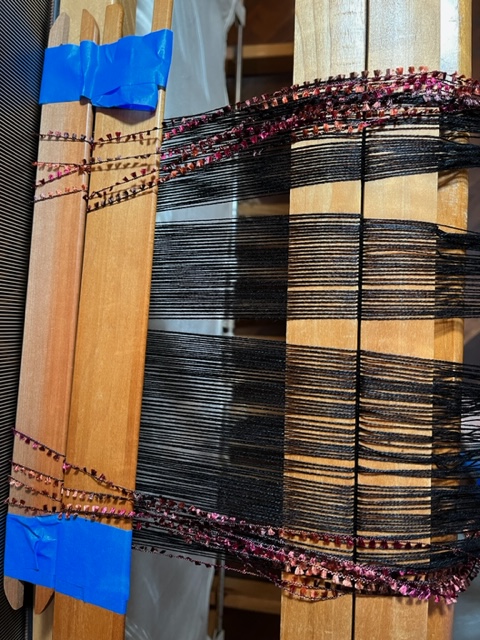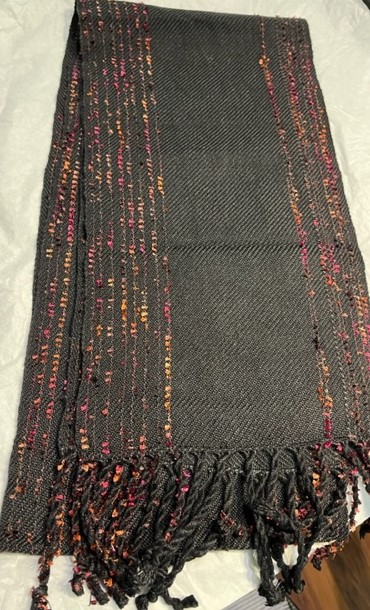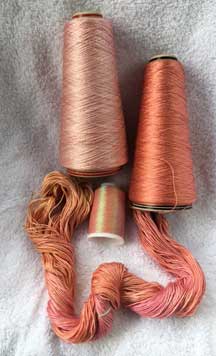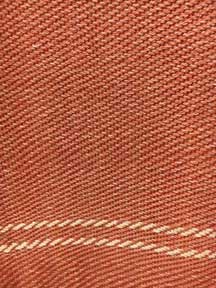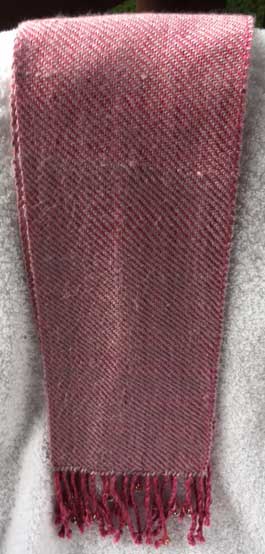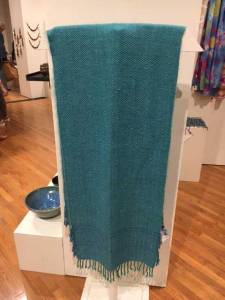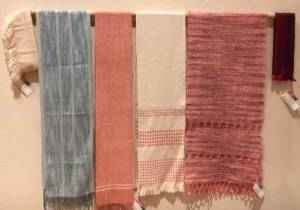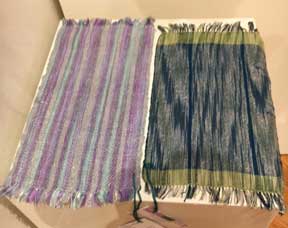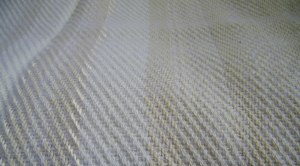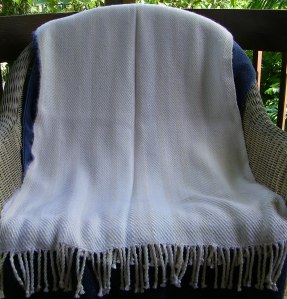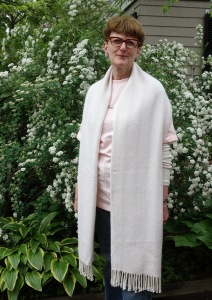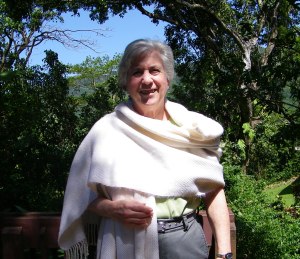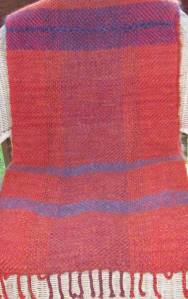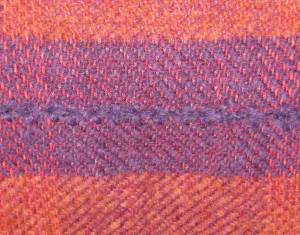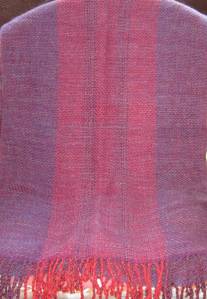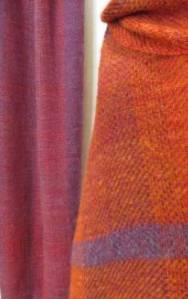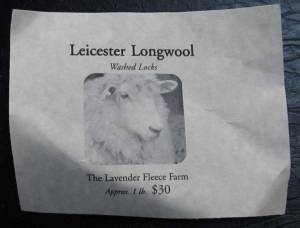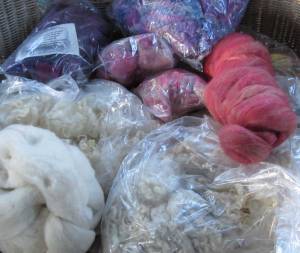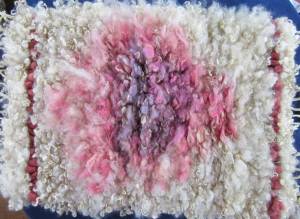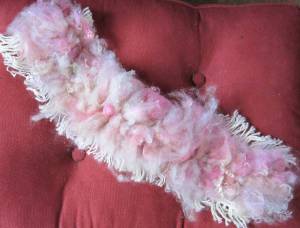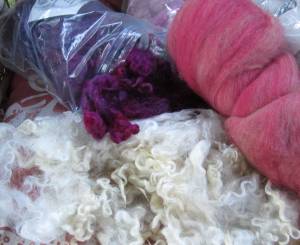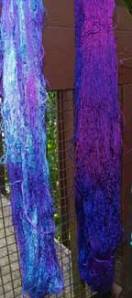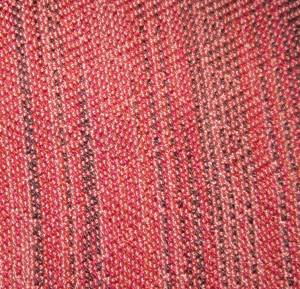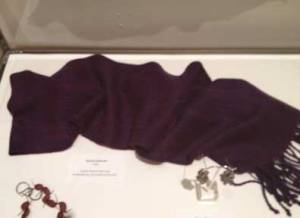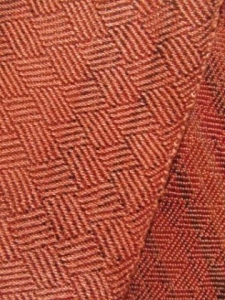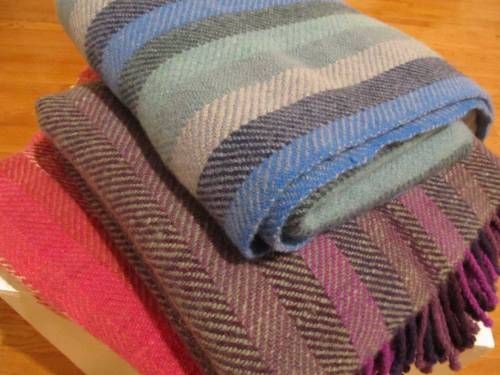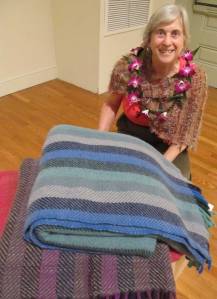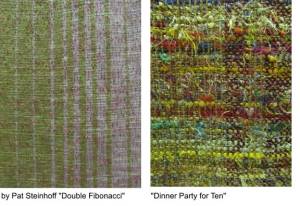I am in Tokyo for three weeks of research and of course, a bit of yarn shopping and flea market visiting on the weekends. The first Sunday my yarn and flea market shopping friend Yasuko and I set off for a new flea market in Tachikawa because our favorite at Togo Jinja has closed permanently. There wasn’t much to see, and it was the first time ever that I’ve gone to a flea market and not bought anything.
Our next stop was Yuzawaya yarn store in Kichijoji, which used to be our favorite. Originally this was a really big yarn store right next to the Inokashira line train station, but a few years ago while the station was being renovated they moved to two floors of the Marui department store a few blocks away. We went to Marui, only to discover that Yuzawaya had moved again, this time into permanent quarters in a new building next to the station. I don’t know if it was because of the move, but the selection was not nearly as good as in past years.
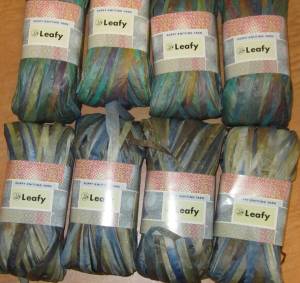
Two different blue Leafy washi paper yarns from two different yarn stores. The top one is blues and greens, while the bot
I had an order to fill for a friend in Honolulu, who wanted four skeins of Leafy washi paper yarn in a variegated blue for which she had given me a color number. However, it turns out that Leafy changes color numbers every year, and this number was a couple of years old and sold out. There was a new blue and green one, so I bought four skeins of that. That was the only thing I found of interest at Yuzawaya in Kichijoji.
We then moved on to the Okadaya yarn store in Shinjuku, which in the past has not been as good as Yuzawaya. This time, it was better. They had a second blue Leafy, this one with some tan in it. I bought four of those and my friend can take her pick. I will add the other one to my stash, since I often weave with Leafy.
We also discovered a really interesting knitting pattern for a sort of neckpiece-shawl that used three balls of an Italian variegated yarn called Mela Naif, which is 45% cotton, 42% wool and a little polyamide. Yasuko was first buying it to knit summer socks, but then we saw the pattern by Bernd Kestler in a kit. We each decided to buy the yarn for the little shawl, but they didn’t have the color we wanted in the kit. A little negotiation produced a substitution so we were able to buy one kit plus another set of three balls of yarn in a different color combination. That was it for the first Sunday. I had to finish half a sock for my husband before I could start on the neck piece, but fortunately, the smaller needle that I use for the heel and sock bottom was the right size. So soon we were both knitting our neck pieces.
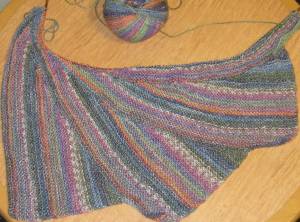
First three triangles of the small shawl, which will have eight when finished. Triangle shaping made with short rows. Design by Bernd Kestler.
The designer calls it a shawl because it does barely cover the shoulders, but he suggests that it can be expanded if you want a real shawl. It is made up of triangles that are produced by the same stitch we use for short row heels, so as soon as we figured that out, we felt very confident. It took me a little while longer to figure out how to read the Japanese knitting pattern, which is very different from a standard American one and has extensive diagrams of the stitches plus some helpful photos on the back to show how to do the required
stitches.
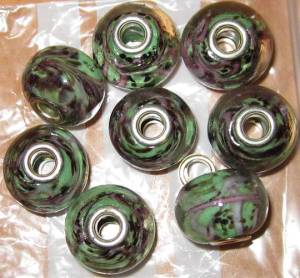
Glass beads with large openings similar to Pandora beads. I’ve turned two on their sides so you can see the mottled pattern that has some lavender in it.
The following Sunday we went in the opposite direction to a new (to us) flea market at Tomioka Hachiman Jingu in Monzen Nakacho. This one was quite large and had lots of interesting things. There weren’t many kimono but we both were entranced by two trays of beads with little picks for picking them up, sort of like eating escargot. I sometimes put beads on scarves and shawls, and after picking around for a while I found eight of the same pattern beads, similar to Pandora beads but a much more reasonable 100 yen (a dollar) per bead. They are too big for scarves, but I bought them thinking they might work for shawls, where I sometimes put in two or three rows of a fatter weft yarn and leave the tails hanging, and then attach beads to the tails. It helps weight the ends of the shawl and adds a nice finishing touch, but requires that I take careful notes to make sure both ends are reasonably similar and that I have enough matching beads. Now that I’ve taken the beads out to photograph them, I think they are probably too heavy to use on the finer weight wool shawls I’ve been weaving recently, but I’ll find some use for them. I also bought a 1950s Japanese movie poster of a film based on some famous early postwar antiwar books, but that’s another story that doesn’t belong in this blog!
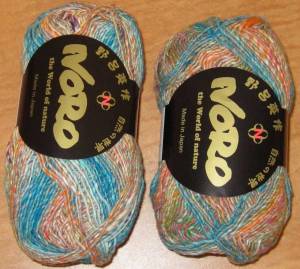
Noro Kibou yarn for a Baby Surprise sweater. The yarn is 54% cotton plus wool and silk, so I think it should be hand washable.
After our success at that flea market we went back to Shinjuku for lunch and then discovered that there is a new Yuzawaya on the 11th floor of the Takashimaya department store near the South entrance to Shinjuku station, which has been built up in the last few years. This one had a better selection than the Kichijoji one, and I ended up buying some Noro yarn called Kibou for a Baby Surprise sweater I need to knit this summer. Later we gravitated back to Okadaya, where they had a new stock of Naif Mela with a lot of new colors. I bought another three balls for a second of the Kestler shawls.
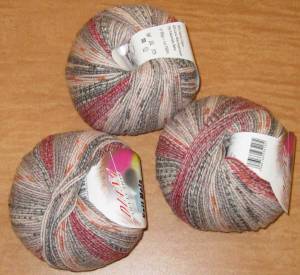
Naif Mela yarn for a Kestler shawl in reds, pinks, and grays.
Then today I went to Kichijoji to have lunch with two of my former graduate students, Chris Bondy and Eiko Saeki, who met and married in Hawaii and are now living in Kichijoji with their charming two-year old bilingual son Aiden. After lunch we went for a walk in Kichijoji because they wanted to show me a new weaving shop that is near Avril. The weaving shop is run by a grandson of the founder of Saori weaving. It has a bunch of Saori looms–to my surprise, they even had a very wide regular two harness Saori loom plus a narrower four harness one. They offer one-shot classes with pre-warped looms, but the main offering is similar to a gym: for a monthly membership fee of 10,000 yen (about $100), you can come in and weave as much as you want. To make this feasible, they have a system where at the end of a weaving session you remove your warp from the loom, leaving it threaded and attached to small removable front and back beams. It is then packed into a box for the next time you come. Meanwhile, the loom is available for anyone else to use, with a different reed and beams. (I took some pictures of this shop with my IPhone and can’t get them off until I get back to Honolulu, so those will be added later.)
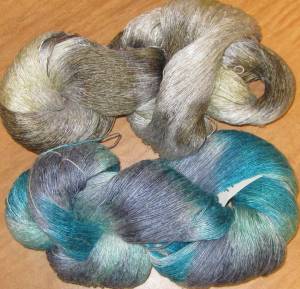
Two skeins of kasuri (ikat) dyed silk from Avril in Kichijoji.
A few minutes more walking through Kichijoji’s fascinating shopping area and we came to Avril. Although I love to go to Avril, usually I find it too expensive. They actually sell yarn in 10 meter lengths for several hundred yen, which is prohibitively expensive if you are used to buying weaving yarn by the skein or cone! This time I lucked out. They had some lovely hand-dyed silk in skeins of about 90 to 95 grams, at 10 meters per gram, which worked out to about 90 to 95 meters–plenty for a scarf. They were selling for roughly $35 a skein, which I thought was reasonable for such silk. I ended up buying two skeins. I will use them as warp stripes, measuring the warp so the color patterns match up for a kasuri or ikat effect. The yarn feels a little stiff on the skein, but they had a sample scarf that was loosely woven using the yarn for both warp and weft so that it had a plaid effect. I don’t like to do that with these types of yarn, but the good thing was that the finished scarf was very soft and did not have any of the original stiffness.
All in all, I’m happy with my yarn shopping on this trip to Japan. I will be back for a couple of weeks in July, based in Yokohama for a week at a conference, and I had been thinking that would be close to the Kamata branch of Yuzawaya….




